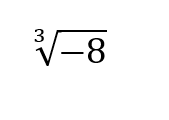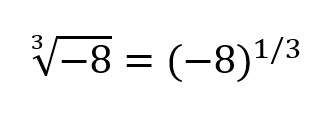function-plot
 function-plot copied to clipboard
function-plot copied to clipboard
x^(1/3) Not good
I was working and when playing with some settings i noticed that when i tried to graph x^(1/3) it didn't draw it properly, as it showed the positive side, but on the negative side nothing was drawn. Here its the configuration
{
"data": [
{
"fn": "x^(1/3)",
"nSamples": 16000,
"graphType": "polyline"
}
],
"xAxis": {
"domain": [
-7,
7
]
}
}
This is how it should be:
 And this is what the programm graphed (Note that the straight line and the text where other things not related):
And this is what the programm graphed (Note that the straight line and the text where other things not related):

Thanks for the bug report! The problem is in the native Math.pow function which returns NaN if the base is negative and the exponent is a float number.
To correctly evaluate an expression like there are a few options:
- analyze the arguments in the pow nodes (somehow find out from the inner AST nodes that we have an odd/even root)
- do an approximation
Going for the approximation seems reasonable but it's not trivial to implement:
- I read https://martin.ankerl.com/2007/10/04/optimized-pow-approximation-for-java-and-c-c/ and something in JS similar could be done with https://stackoverflow.com/questions/21280440/converting-two-uint32array-values-to-javascript-number/21282715#21282715
I tried a few examples of https://martin.ankerl.com/2007/10/04/optimized-pow-approximation-for-java-and-c-c/ and the results were far from good:
I have an idea, but i do not know how to implement it. So, having in mind that it calculates the values correctly when the input is positive, we could do something like this:

Explanation:
- |x| means the absolute value of x, basicly if Enters: positive Out: positive Enters: negative Out: positive
- sign(x) means the sign that has x. For instance, if x is -14, then sign(x) is -1. Like is only the sign. What all of this is doing is converting the input to positive, calculate the ^(1/3), and then aplying the sign.
Hope this helps.
Thanks for the suggestion, I think that the formula depends on the exponent denominator, let's take two examples:
- $x^\frac{1}{2} = \sqrt{x}$ and this is only defined for $x \geq 0$, this happens for every even denominator
- $x^\frac{1}{3} = \sqrt[3]{x}$, it's defined for any rational number $x$, this happens for every odd denominator
As you can see it's a matter of analyzing the denominator if the power is a fraction
The definition of the power function $a^x$ requires that $a$ is positive. I don't think this is a bug. The current plot is correct.
Edit: If you want the first plot it should be the function $\sqrt[3]{x}$.
Edit: @mauriciopoppe That means if this is "fixed" then the fix would actually be a bug. Thank you so much for this great library btw!
@minhhai2209 That is a false argument. I will use this as an example:
 What this expression does, is search a number, that multiplied by itself 3 times equals to a. Thus, it does not need to always be positive. Lets say that we are finding:
What this expression does, is search a number, that multiplied by itself 3 times equals to a. Thus, it does not need to always be positive. Lets say that we are finding:
 If the 8 was positive, the solution would be 2, as (2)(2)(2) = 8. But, we have a negative number. However we can get negative numbers as a result: (-2)(-2)(-2) = -8. This happens because it isn't an even number of multiplications, so the negative signs don't cancel each other out. And how this all relates to exponents, roots are a representation of exponentials:
If the 8 was positive, the solution would be 2, as (2)(2)(2) = 8. But, we have a negative number. However we can get negative numbers as a result: (-2)(-2)(-2) = -8. This happens because it isn't an even number of multiplications, so the negative signs don't cancel each other out. And how this all relates to exponents, roots are a representation of exponentials:
 Thus, in conclusion, what you said, that it needs to be positive, will only be true when the denominator of the exponential is even.
Thus, in conclusion, what you said, that it needs to be positive, will only be true when the denominator of the exponential is even.
@mauriciopoppe I agree on what you said. So, to solve the problem, we would need to know if the denominator is odd in order to apply the formula i mentioned a few comments ago?
I will change prespective, as I find easier to work with even numbers. So, what we can do is exactly the opposite: See only if it's even and not apply the formula.
So we are searching numbers that fall in these two categories:
- It has to be even
- It does not have any decimal digits
we could identify any even number just dividing by 2, and if we get a result that has no decimals, it would be an even, and the solution wouldn't be applied. In any other case, that it isn't even, we would apply the solution.
As I said in my other comment, i do not know what tools are available in your framework to make this work. So I don't know how would you implement such a thing. Hope everything helps.
@APCAPCAPC Per the formal definition the function $a^{1/3}$ is different from the function $\sqrt[3]{a}$. What you have written
 is simply wrong.
is simply wrong.
More discussion here https://www.researchgate.net/publication/226461615_To_define_or_not_to_define_The_case_of_-813.
The solution to ${-8}^{1/3}$ can only be possible using complex numbers.
@minhhai2209 That is a false argument. I will use this as an example:
What this expression does, is search a number, that multiplied by itself 3 times equals to a. Thus, it does not need to always be positive. Lets say that we are finding:
If the 8 was positive, the solution would be 2, as (2)(2)(2) = 8. But, we have a negative number. However we can get negative numbers as a result: (-2)(-2)(-2) = -8. This happens because it isn't an even number of multiplications, so the negative signs don't cancel each other out. And how this all relates to exponents, roots are a representation of exponentials:
Thus, in conclusion, what you said, that it needs to be positive, will only be true when the denominator of the exponential is even.
@minhhai2209 I see the problem now. Thanks for referencing that paper, it helped a lot.
So, this sort of reminds me of
 Because it has two solutions, -1, +1, we take the positive one. And I think we could do something similar here.
Because it has two solutions, -1, +1, we take the positive one. And I think we could do something similar here.
I'm still having a mental debate between the two solutions, as for me both make some sense. I would like to hear what do you think
This issue has been automatically marked as stale because it has not had recent activity. It will be closed if no further activity occurs. Thank you for your contributions.
This issue has been automatically marked as stale because it has not had recent activity. It will be closed if no further activity occurs. Thank you for your contributions.
Could you find all the roots then take the non-complex result?
This issue has been automatically marked as stale because it has not had recent activity. It will be closed if no further activity occurs. Thank you for your contributions.
Hey guys, after so many months I remembered I already implemented this a long time ago (in 2015 https://github.com/mauriciopoppe/interval-arithmetic/commit/baf57bdce3b327a9aec4b9d5a57be50f0212dba3) 😅. While you can't use x^(1/3) you can use a function called nthRoot.
functionPlot({
target: '#playground',
data: [
{
fn: 'nthRoot(x, 3)',
}
]
})
https://codesandbox.io/p/sandbox/silent-firefly-z8wjp7